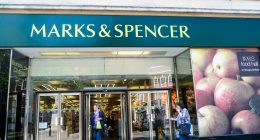MILLIONS of children across the UK can continue to get free school meals even if it is shut.
The government has said it will keep funding the support for families with young children and low-income households through lockdown.
⚠️ Read our coronavirus live blog for the latest news & updates
It comes as primary and secondary schools have been forced to close until at least February half term to help slow the spread of the coronavirus.
They will only stay open for vulnerable children and the children of key workers. Nurseries are allowed to stay open as usual.
Schools can choose to issue the support through food parcels or supermarket vouchers.
Here, we take you through everything you need to know about the voucher scheme, from who can claim them to where to spend them.
1. You don’t have to be on benefits to claim them
In England and Scotland, children in reception, year 1 and year 2, and who attend a state school, are automatically entitled to free school meals.
This is regardless of your household income.
For school children across the UK in year 3 and older, their families must be claiming certain benefits before being entitled to free school meals.
Eligibility varies slightly between England, Wales, Scotland, and Northern Ireland because the devolved nations set their own rules.
New claims made from April 2018 in England must come from households earning a maximum income of £7,400 a year after tax, not including any benefits.
Rules are the same in Scotland and Wales, but in Northern Ireland, the household income threshold is £14,000.
In England, you must also be claiming one of the following benefits:
- Income support
- Jobseeker’s allowance (JSA)
- Employment and support allowance (JSA)
- Support under part VI of the Immigration and asylum act 1999
- Pension credit
- Child tax credit
- Working tax credit
- Universal Credit
You can find out more details on the eligibility criteria in Scotland, Wales and Northern Ireland on the government websites.
2. They’re worth £15 a week per child
The vouchers are worth £15 a week per child that is eligible, and are issued by schools.
Schools can send out vouchers in several amounts:
- A single voucher to cover multiple weeks, for example, a £30 voucher to cover one eligible child over two weeks
- A single voucher to cover more than one eligible child within the same household, for example, £60 to support two eligible children over two weeks
- A weekly £15 rolling voucher, up to the week commencing February 8
3. They may be sent as e-gift cards
The Department of Education (DoE) is working with Edenred UK to supply the vouchers – the same firm that helped with the scheme during the first national lockdown in March 2020.
Schools are responsible for ordering them on pupils’ behalves.
Exactly how you receive the vouchers depends on how your child’s school decides to issue them.
Some schools have decided to send e-gift cards sent to parents by email, while others are asking parents to collect printed vouchers from schools.
Schools should have been contacted by Edenred by January 14.
If in doubt, you should contact your school in the first incidence to discuss the vouchers.
4. You can spend them on the high street
The vouchers can be spent in the following supermarkets and newsagents:
- Aldi
- Asda
- Company Shop Group
- Iceland
- Marks & Spencer (M&S will boost £15 vouchers to £20)
- McColl’s
- Morrisons
- Sainsbury’s
- Tesco
- Waitrose
Schools can also purchase vouchers for other supermarkets and claim back the costs from the government.
5. M&S will boost its value
M&S has said it will add an extra fiver to the value of the school meal vouchers when they’re spent in one of its stores.
This means that parents will be able to get £20 worth of food in total, which M&S says will help kids get a free breakfast too.
To get the vouchers boosted at M&S, parents should exchange their eCode issued via the free school meals scheme to get an M&S giftcard.
The gift card will automatically be loaded with the extra £5 which you can spend it in store.
After you’ve loaded up your basket, simply go to the checkout and hand over the voucher.
6. You can claim them online
How you claim the free school meals depends on where you live, but some districts let you apply online.
Start by entering your postcode into the Gov.uk website to see what the process is in your area.
There’s a different process if you live in Northern Ireland, Scotland, or Wales.
If it’s not possible to apply online, you’ll need to either get a form to fill in from your school or call your local council.
It’s worth pointing out that if you claim housing benefit or council tax support you can apply for free school meals when you are filling out your forms.
7. You can’t claim them for half-term
The DoE has told schools not to dish out the vouchers for kids over the February half term.
The unpopular decision received backlash from some MPs who believe struggling families need the state support now more than ever.
Schools don’t normally provide free meals through the holidays but the government agreed to extend the policy through the Easter, half-term and summer breaks during the first national coronavirus lockdown.
But in October last year, MPs voted against continuing the support but the government made a u-turn a week later following a high profile campaign by England footballer Marcus Rashford.
The PM unveiled a £170million Covid Winter Grant Scheme to ensure the poorest families can pay bills and put food during the term-time breaks.
It is a different scheme to the free school meals one so families will need to apply for it separately, regardless of whether they already get free school meals.
There are also fears the amount households receive could be slashed as there is no guarantee it will meet the £15 per head voucher as is the case in term time.
Struggling households will need to apply for the cash through their local council. You can find your local authority and how to contact them on Gov.uk.
8. The vouchers will stop when schools reopen – but free meals won’t
The vouchers are only being issued while the government has ordered all schools to close during the coronavirus lockdown.
When they are allowed to reopen, schools will continue to provide free meals in the same way they normally do.
There are hopes schools may be able to welcome back pupils after half term in mid-February if the government’s vaccine roll out goes to plan and the rising Covid-19 cases fall.
However, they will have to stay shut if the number of new infections continues to rise out of control.
Why are some families being given food hampers instead?
Instead of supermarket vouchers, schools can claim up to £3.50 per pupil, per week, on top of their usual funding to provide food parcels to children at home.
The government is urging schools to use this approach wherever possible, but it is ultimately up to each establishment to decide whether to send vouchers or parcels.
But the food packages have been met with controversy after parents say they’ve been handed tiny parcels containing paltry supplies.
With the vouchers, parents have the freedom to decide what to buy their children for lunch.















